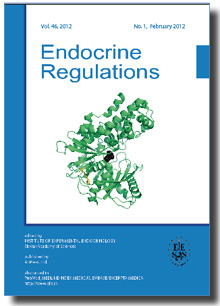Journal info
|
||
Select Journal
Journals
Bratislava Medical Journal Ekologia - Ecology Endocrine Regulations 2015 2014 2013 2012 2011 2010 2009 2008 2007 2006 2005 2004 2003 General Physiology and Biophysics Neoplasma Acta Virologica Studia Psychologica Cardiology Letters Psychológia a patopsych. dieťaťa Kovove Materialy-Metallic Materials Slovenská hudba 2025Webshop Cart
Your Cart is currently empty.
Info: Your browser does not accept cookies. To put products into your cart and purchase them you need to enable cookies.
Endocrine Regulations Vol.46, No.4, p.191–203, 2012 |
||
| Title: Thyroid volume, iodine intake, autoimmune thyroid disorders, inborn factors, and endocrine disruptors: twenty-year studies of multiple effects puzzle in Slovakia | ||
| Author: P. Langer, M. Tajtakova, A. Kocan, B. Drobna, L. Kostalova, G. Fodor, I. Klimes | ||
| Abstract: Objective. The aim of this study was to evaluate multiple interrelations between several endogenous and exogenous effects and the thyroid volume and function in large groups of children, adolescents, and adults with a sufficient whole life intake of the iodine. Subjects and Methods. The data were obtained either by cross sectioned or longitudinal studies in a total of 4998 children and adolescents (aged 7 to 17 years) and 2501 adults (1071 males and 1430 females aged 20-75 years). Thyroid volume (ThV) was measured by ultrasound, antibodies, and hormones by electrochemiluminiscent immunoassay, and endocrine disruptors (EDs, polychlorinated biphenyls-PCB, dichlorodiethyl-ichloroethylene-DDE, and hexachlorobenzene-HCB) by high resolution gas chromatography/mass spectrometry. Results. 1. In large groups of boys and girls of age 7, 10, 13 or 17 years, the ThV was significantly higher in the 10th decile than in pooled nine lower deciles. Moreover, in 17-year old subjects significantly higher prevalence of hypoechogenicity by ultrasound, positive thyroperoxidase antibodies (TPOab), and increased thyrotropin (TSH) levels were found in the 10th decile. 2. In a small group of children, some individuals revealed consistently higher ThV during the whole 7-year follow-up period irrespective of supplementation with iodine. 3. In 325 sibling pairs of age 10-19 years, born within three years, three groups with different ThV/m2 of body surface were distinguished: Group A (183 pairs having both ThVs small), Group B (103 pairs having both ThVs large); Group C (33 pairs having one ThV small and the other one large). Similar aggregation of ThVs in three groups was observed in 13 pairs of discordant twins and 19 sibling triads in which all the siblings were born within four years. 4. In 42 concordant twins, several pairs had ThV nearly twice as high (in terms of both plain ThV or ThV/m2 of the body surface) as several other pairs of the same age which is assumed to be a result of a genetic background. 5. In large cohorts of males and females, a highly significant positive correlation was found between the ThV and high level of TPOab on one side and EDs on the other side. However, in nearly the same numbers of subjects with low TPOab, negative correlation was seen between ThV and disruptors. These observations may apparently support the synergic effect of the autoimmunity and EDs on the thyroid function. Conclusions. Several cases of an excessive thyroid growth in the iodine replenished children, adolescents, and adults may apparently result from the autoimmune thyroiditis, probably induced by immunogenic action of iodine in presumably disposed individuals. However, in some cases even simultaneous participation of EDs can not be excluded. Some observations have also suggested that excessive thyroid growth in the iodine replenished adolescent and adult population which was equaly exposed to disruptors may also result from other reasons as the unfavorable hereditary background. |
||
| Keywords: thyroid, iodine, autoimmunity, endocrine disruptors, inborn factors, siblings | ||
| Year: 2012, Volume: 46, Issue: 4 | Page From: 191, Page To: 203 | |
| doi:10.4149/endo_2012_04_191 |
||
|
Price:
26.00 €
|
||
|
|
||

